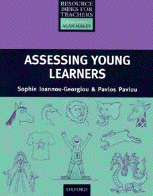Teachers Learning with Children. Vol. 9, No. 4. 2004-2005. (p. 43-46)

Book Review -
Assessing Young Learners:
Directed Reading & Thinking Activities for Second Language Students
by Sophie Ioannou-Georgious and Pavlos Pavlou
Oxford University Press. 2003. (ISBN: 0-19-437281-2)
Written in a non-academic style for K-6 EFL/ESL teachers, this text outlines about sixty language activities to informally assess the language abilities, attitudes towards learning, and classroom feelings of young learners. Although the book fails to cover basic testing principles in depth, it does provide an interesting hodgepodge of photocopyable materials to supplement EFL/ESL classes for children.
The authors contend that young children are often "negatively influenced" by assessment techniques geared to adults (p. 3) and provide an overview of ten common alternative assessment activities such as peer assessment, self-assessment, and portfolio assessment. Ioannou-Georgious and Pavlou's believe in the importance of fostering self-esteem and providing incentives to learning. Assessement, as presented in this book, seems like an afterthought.
The first chapter is essentially a case in favor of classroom portfolios. Though some practical advice about conducting portfolio reviews is offered, unfortunately no sample student portfolios appear. Moreover, none of the potential problems associated with portfolio usage outlined by Gómez (2000) and Endo-Crum, Pinsky & Chang (2001, p, 356-370) are considered. One of the weaknesses of this text is that the authors advocate various activities without considering their potential drawbacks – basically, critical analysis is missing.
The next chapters mention how each of the four basic language skills can be assessed. Each chapter starts with a fluffy discourse about a particular skill, then outlines 5-6 classroom activities. For example, the chapter on speaking assessment describes a short information-gap activity in which students draw various monsters, then compare them. The text recommends a few students then be rated in terms of fluency, task achievement, and pronunciation according to a written three-point scale. The most interesting activity in this section features a passage about an alien world that students read then color. For this activity the authors suggest students assess themselves by drawing 1-8 stars at the top of their worksheets – obviously, the focus is more on positive enjoyment than formal accuracy.
| "Though this book does not provide a good exposition of testing principles or mention ways to develop more reliable and valid tests, if you simply regard this text as a sort of cookbook . . . some of it will be useful." |
Chapter 6 provides three lengthy 4-skill language lessons. For example, in one activity students give group presentations about their favorite musicians, then receive peer feedback on overall content, voice clarity, and use of audio-visual aids.
Next, ways to assess grammar among young learners are considered. Four activities highlighting specific grammar functions are mentioned. In the first activity, as a case in point, children read a passage about animals in various locations, then color their worksheets accordingly.
Chapter 8 considers the issue of self-assessment. A few general hints on how to encourage positive self-assessment are offered, unfortunately without detailed examples. Eight ways for students to assess various aspects of their language performance and attitudes towards language or classroom activities are also briefly mentioned. For instance, students rate their speaking skills by answering a series of questions by using either smiling faces, poker faces, or frowning faces. One concern about such activities if they are used for placement or grading such ratings tend to become skewed. The authors do not address this concern, nor mention the limitations of each assessment method outlined.
Ways to foster awareness of "learning how to learn" are considered in Chapter 9. Activities promoting dictionary skills, word-guessing skills, content-predicting skills, and paraphrasing skills are briefly cited.
The final chapter offers practical advice about record keeping and reporting. Ways to assess both general performance over many classes and achievement in one class are considered.
Those regarding this 183-page text as a serious work about language assessment for young learners will be disappointed. Cameron's (2001) text does a much better job in that regard. However, K-6 ESOL teachers who dislike traditional language assessment activities will probably appreciate some of the activities mentioned herein. Though this book does not provide a good exposition of testing principles or mention ways to develop more reliable and valid tests, if you simply regard this text as a sort of cookbook with a medley of activities with informal assessment components, chances are some of it will be useful.
- Tim Newfields
References
Dixon, C., & Nessel, D. (1983).The Language Experience Approach to Reading: LEA for ESL. Hayward, CA: Alemany Press.
Endo-Crum, S., L. Pinsky, & M. Chang. (2001). Using portfolios as a means of assessment. In M. Swanson, D. McMurray (eds.). PAC3 at JALT 2001: A Language Odyssey. Tokyo: JALT. (pp. 356-370).
Gómez, E. (Dec. 2000). Assessment portfolios: Including English language learners in large-scale assessment. CAL Digest #EDO-FL-00-01. Retreived from the World Wide Web at www.cal.org/resources/digest/0010assessment.html on 6 June 2004.